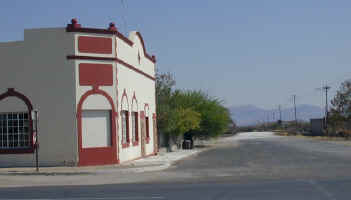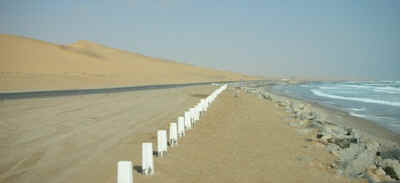As to the salt road. It is really made of the salt from the salt pans which are plentiful along the west coast. The gypsum, which is one of the components in the salt binds with the sand, the salt as such helps to catch the water from the fog that keeps the mix from drying out and form a hard crust. It is a good road to travel on, like a tar road. This road can not exist where it rains or where the air is dry.
We traveled from Windhoek to Karibib, visited the cemetery at Usakos and took the turn-off into the dust road. That took us to Henties bay, from there along the salt road to Swakopmund and tar road to Walvis bay

Karibib - can you believe that quiet street? I am standing in the main road taking this photo. This is the main road down to the coast, so there are often cars travelling through and some people on the main road at the few shops. There is one shop that we do not pass when we are in Karibib and that one sells gemstones and rock crystals. It looks like nothing from the outside, but inside it is huge with the things that glitter which stops a woman's heart. sighhhh

I need some information here regarding the photo (above). Please take a close look. The large obvious plant without leaves is a Cyphostemm species, I want information on the plant with the thin branches next to the Cyphostemma. The plant with the thin long greyish branches and pretty seedpods which look like wings of a bird flying. Those pods are large. One pod is nearly the length of my hand. In the background is the Karibib police station.

At Usakos the plants were dry with no sign of the wide spread rain that fell in the rest of the country. The Aloe hereroensis in the old cemetery were not in flower like Aloe hereroensis in the southern areas of Namibia. Some of the aloes showed a faint green coloring in the center of the rosette assuring me that these aloes are tough, they will survive.

The dust road to Hanties bay. The grass fields in the desert are unbelieveable ! We never saw so much grass in the desert before. The local habitants (mainly small animals and insects) did not experrience this in a century.

The main road between Swakopmund and Walvis bay. Lovely picturesque dunes.
Below:- The crane pulling the fishing boat out of the sea. The fishing boat is past the point of seafaring ever again, it will be sold as scrap.
Imagine what it would have been like centuries ago to land on this shore. Nothing but large dunes. Not altogether so bad as the mouth of the Swakop river is less than 5 kilometres away. Skeleton Coast starts to the north, but anybody shipwrecked would not be able to get far without water on this coast, even if they are not yet in the skeleton coast area.

One of the trees adapted to the life in the desert. The branches are not higher than 40 cm at the most and the diameter of the tree with all branches included is not quite 2 m. but the tree is actually larger as the main stem is underground like a huge water reservoir.

Aloe asperifolia can survive the desert habitat very well. The plants are in excellent condition with the pale green plants showing new growth. The thick leaves are full of moisture which are absorbed dew or fog from the sea-air.
Most plants have bloomed out. The single raceme with flowers that we saw was very small and not much to look at. It happens that aloes send out a sub-standard raceme after it bloomed. It shows the typical sideway growth of the inflorescens.









